Gratis Geschenk ab 40 € | Gratis Versand ab 35 € | Gratis exklusives Plektrum ab 60 €
-
Shop
- Insights
-
Über ROMBO
- Händler
- Plektren-Finder
- Geschenkgutschein
+Kategorien
- accessories
- bass
- bass pick
- bass picks
- bass plectrum
- bass plectrums
- beginner
- bright tone
- chose guitar pick
- chose guitar picks
- chose plectrum
- chose plectrums
- CrystalBright
- Diamond
- Diamond pick
- discipline and guitar
- DIY generation
- durability pick
- durable pick
- eco
- ecoblack
- find guitar pick
- find plectrum
- fingers vs picks
- grip
- grip guitar pick
- guitar accessories
- guitar advantages
- guitar benefits
- guitar career
- guitar health
- guitar injury
- guitar learn
- guitar lesions
- guitar lesson
- guitar method
- guitar noise
- Guitar noise plectrum
- guitar pain
- guitar pick
- guitar pick beginner
- guitar pick bevel
- guitar pick buy
- Guitar pick diamond
- guitar pick durability
- guitar pick durable
- guitar pick eco
- guitar pick features
- guitar pick grip
- guitar pick material
- Guitar Pick Noise
- Guitar Pick online
- guitar pick recycled
- guitar pick recycled material
- guitar pick special features
- guitar pick textures
- guitar pick thickness
- guitar pick variable thickness
- guitar picks
- guitar tone
- guitar warm-up
- guitarpick
- guitarpicks
- hold a guitar pick
- hold guitar pick
- hold guitar picks
- hold pick
- hold plectrum
- hold plectrums
- how to
- how to chose your guitar picks
- jazziii
- learn guitar
- lose guitar pick
- material
- materials
- mental health and guitar
- motivation and guitar
- music
- not to lose guitar pick
- Online guitar
- online guitar pick
- online guitar pick buy
- pick
- pick durability
- pick material
- pick noise
- Picks
- picks vs. fingers
- play bass fingers
- play bass picks
- play bass with fingers
- play bass with pick
- play bass with picks
- play bass with plectrum
- play guitar faster
- plectrum
- plectrum attributes
- plectrum beginner
- plectrum bevel
- plectrum characteristics
- plectrum features
- plectrum grip
- plectrum material
- plectrum noise
- plectrum recycled
- plectrum shape
- plectrum variable thickness
- plectrums
- Plek
- pua
- recycled
- recycled guita pick material
- recycled guitar picks
- recycled picks
- recycled plectrum
- Rombo Diamond
- rombopicks
- tendonitis guitar
- the guitar pick
- tone
- variable thickness
- warm tone
- warm-up guitar

WIE ÜBER 2000 GITARRENSPIELER UNS GEHOLFEN HABEN, UNSERE GITARRENPLEKTREN FÜR 2023 ZU GESTALTEN:
Im Juni 2022 haben wir die ersten 3D-Skizzen unserer vier neuen Plektrum-Modelle fertiggestellt. Die Picks waren jedoch nicht zu 100 % fertig.
Die Dicke, Größe und sogar die Namen der Plektren waren noch nicht definiert.
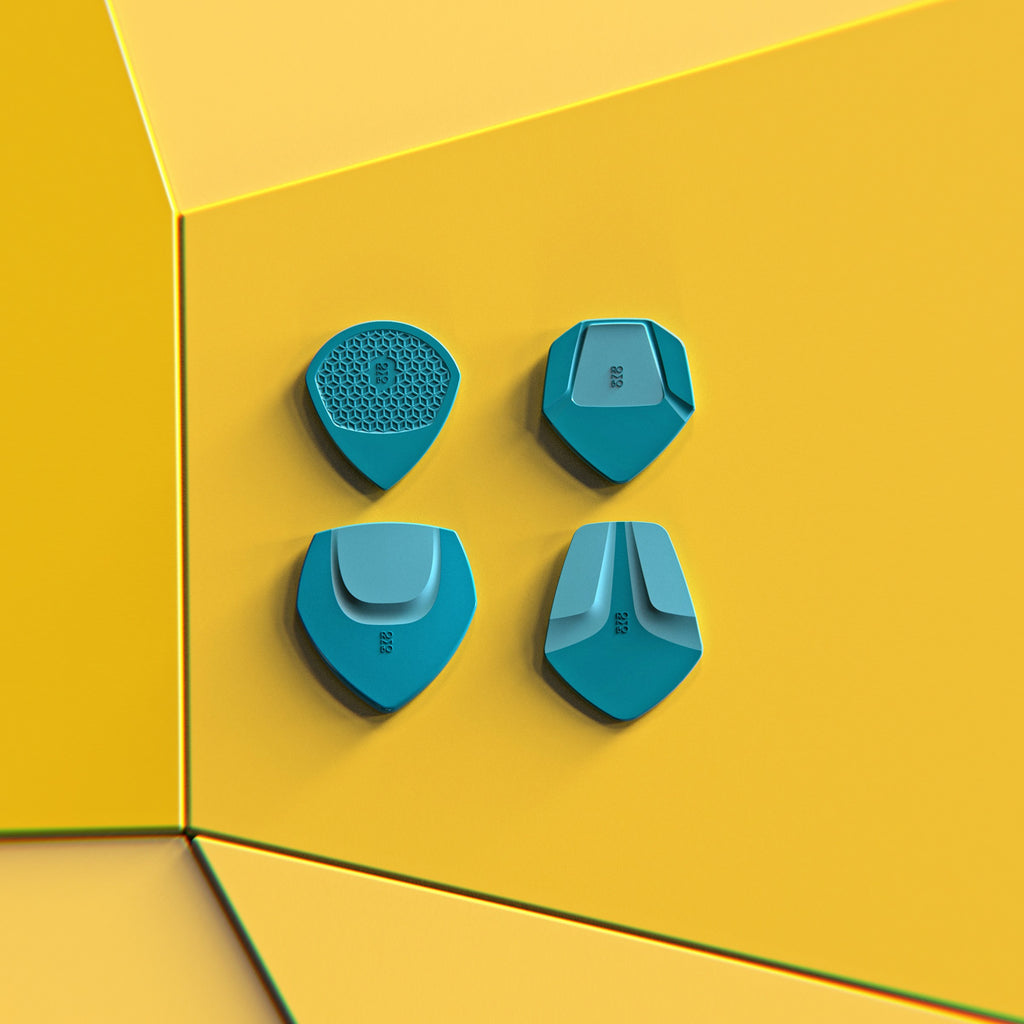
Wir haben uns für den Ansatz entschieden, so viele Gitarristen wie möglich einzubeziehen, um uns beim Co-Design unserer neuen Gitarren-Plektren zu helfen.
Das Ziel dieses Artikels ist es, die Ergebnisse der Umfrage zusammenzufassen, an der 2122 Gitarristen teilgenommen haben. Diese Leute haben das endgültige Design unserer Picks direkt beeinflusst.

Die Gitarren-Community hat Rombo seit seinem Start im Jahr 2019 stark unterstützt.
Wir wollten keine neuen Gitarrenpicks kreieren, ohne die Leute zu fragen, die von Anfang an dabei waren. Sie alle sind der Kern von Rombo, und Sie sollten entscheiden, welche Produkte wir entwickeln.
Der logischste Schritt war, eine große Umfrage zu erstellen, die es der Community ermöglicht, uns mitzuteilen, wie sie ihre Gitarrenplektren gern hätten. Wir glauben, dass dies der einzige Weg ist, ein Produkt zu entwickeln, das auf den Wünschen unserer Community basiert und uns ermöglicht, grundlegende Entscheidungen über die Ausrichtung unseres Unternehmens zu treffen.

Dies ist nur möglich, wenn man auf die Gedanken jedes Gitarristen hört.
GUITAR PICKS 2023 - ERGEBNISSE DER UMFRAGE
2122 Gitarristen haben an der Umfrage teilgenommen und sich somit am Designprozess dieser neuen Gitarren-Plektren für 2023 beteiligt.
509 von ihnen hinterließen eine private Nachricht mit detaillierten Informationen.
Weiter unten gehen wir auf diese Nachrichten ein.

WAS IST IHR LIEBLINGS-GITARREN-PICK-DESIGN?


Es gibt einen klaren Gewinner. Gitarrenplektrum Nummer 2 ist der Favorit für die meisten Teilnehmer.
Könnte es an seiner Ähnlichkeit in Form und Größe mit dem legendären Jazz-III-Gitarrenpick liegen?
Überraschenderweise ist Nummer 4 das Gitarrenplektrum, das mich während des Prototypentests am meisten überrascht hat. Aber natürlich weiß man nie, bis man es probiert hat!
GITARRENPICK NUMMER 1:

Name:
- Mosaic: 33,4%
- Pegasus: 16,6%
- Sense: 13%
- Summit 6,8%
- Andere Namen: 30,2%
Durchschnittliche Dicke: 0,66 mm
Größe: Kleine Größe mit 89 % der Stimmen
GITARRENPICK NUMMER 2:

Name:
- Shell: 42 %
- Lance: 18%
- Turtle: 8,2%
- Andere Namen: 31,8%
Durchschnittliche Dicke: 0,953 mm
Größe: Mittlere Größe mit 77 % der Stimmen
GITARRENPICK NUMMER 3:

Name:
- Erebus: 52%
- Quasar: 32,1%
- Jupiter: 10,1%
- Moon: 5,15%
- Andere Namen: 0,65%
Durchschnittliche Dicke: >2 mm
Größe: Große Größe mit 55 % der Stimmen
GITARRENPICK NUMMER 4:

Name:
- Dune: 39,8%
- Lance: 31,2%
- Doppler:19,6 %
- Sense: 4,7%
- Andere Namen: 4,7%
Durchschnittliche Dicke: 0,72 mm
Größe: Mittlere Größe mit 85 % der Stimmen
GUITAR PICKS: PERSÖNLICHE GEDANKEN VON 509 GITARRENSPIELERN

Insgesamt 509 Personen haben uns eine private Nachricht bezüglich Gitarrenpleks hinterlassen.
Wir haben sie alle sorgfältig gelesen und werden alle diese Informationen während der Entwicklung berücksichtigen.
Hier sind die 10 häufigsten Fragen, die wir wiederholt erhalten haben, und unsere Kommentare dazu:
● Werden die Plektren in verschiedenen Farben erhältlich sein?
Ja! Die Markteinführung umfasst alle regulären Rombo-Farben.
Weitere „Special Edition“-Farben sind in Vorbereitung.
● Werden sie die gleiche Griffstruktur haben?
Viele Leute haben uns E-Mails und Briefe bezüglich der Griffstruktur geschickt. Mit den Mikronoppen haben wir den Vorteil von mittelgriffigen Oberflächen, die viel Kontrolle hinzufügen.
Eine sehr kleine Anzahl von Menschen möchte jedoch, dass die Picks mehr Grip haben. Wir mussten hier eine Entscheidung treffen, und es war schwer. Wir werden die „Korndichte“ auf den strukturierten Bereichen leicht erhöhen, sodass mehr „Micro nodules“ pro Quadratmillimeter entstehen.
Auf diese Weise hoffen wir, den Bedürfnissen aller Gruppen gerecht zu werden.
● Das Material ist kühl, erzeugt aber warme und sanfte Töne. ich bevorzuge
helle Töne. Plant ihr ein neues Materialsortiment?
Wir haben unser Materialkomposition absichtlich geschaffen, um diese sanften Töne zu erreichen. Etwa 12 % der Benutzer gaben jedoch an, helle Töne zu bevorzugen.
Wir haben beschlossen, mit der Forschung an einem neuen Material zu beginnen, das als zusätzliches Sortiment auf den Markt gebracht wird, sobald wir die richtige Formel gefunden haben. Das voraussichtliche Datum für die Markteinführung des neuen Materials ist Anfang 2024.
● Warum erstellt ihr nicht für jedes Plektrum unterschiedliche Dicken?
der Modelle?
Wir möchten, dass jedes Plektrum einzigartig ist. Da jeder Mensch individuelle Vorlieben hat, glauben wir, dass jedes Plektrum sein eigenes Design haben sollte. In Zukunft hoffen wir, eine breitere Palette von Plektrumdesigns erstellen zu können, um jedes mögliche Bedürfnis abzudecken.
● Was ist mit Plektren für Bassisten?
Die meisten unserer Plektren sind mit Bass kompatibel, wie wir bei einigen Bassisten bestätigt haben, die sie regelmäßig verwenden, insbesondere Rombo Diamond und Rombo Origami. Das haben wir HIER erklärt.
● Ihr solltet Merch, T-Shirts und andere Dinge anbieten:
Vielleicht in der Zukunft. Jetzt wollen wir uns zu 100% auf die Entwicklung der Gitarrenpicks konzentrieren. Jede Minute, die wir für das Design eines T-Shirts aufwenden, wird von der Qualität der Picks abgezogen! ;)
● Werdet ihr die EcoBlack-Reihe in anderen Farben anbieten?
Das EcoBlack-Material kann derzeit nur einfarbig produziert werden.
Durch den Recyclingprozess entsteht eine sehr dunkle Pigmentierung. Die Industrie arbeitet hart daran, einen Weg zu finden, neue Recyclingverfahren zu schaffen. Wir hoffen, dass wir in Zukunft alle unsere Plektren aus recyceltem Material herstellen werden.
● Warum erstellet ihr keine Boutique-Picks?
Gegenfrage: Was ist ein Boutique-Plektrum?
Ein Boutique-Plektrum ist ein einzigartiges Kunstwerk in Form eines Plektrums, das ihr zum Gitarrenspielen verwenden könnt. Normalerweise sind diese Plektren handgefertigt und aus exotischen Materialien. Sie enthalten einige künstlerische Elemente wie Ornamentgeometrien und sind in der Regel einzigartige Sondereditionsstücke mit erhöhten Startpreisen.
Unser Ansatz ist ein anderer. Wir kreieren Boutique-ähnliche Gitarren-Pick-Designs zu sehr erschwinglichen Preisen. Andernfalls wären nur ein paar Rombo-Designs für die einflussreichsten Pick-Sammler verfügbar.
Wir glauben, dass wir auf diese Weise eine Nische zwischen Massenproduktions-Picks und einzelnen Sondereditionen gefunden haben. Mit diesem Ansatz bringen wir das Boutique-Feeling zu einer größeren Anzahl von Menschen und stärken die Plektrum-Community und das Bewusstsein für dieses kleine, aber wichtige Accessoire.
● Einige Plektren, die ich 2019 bestellt habe, hatten Grate. Dies ist kein Problem für
spielen, aber es sieht nicht cool aus.
Wir haben gute Nachrichten für Sie. 2021 haben wir eine neue Methode entwickelt, um die Grate manuell von den Plektren zu entfernen. Das bedeutet, dass alle Rombo-Picks manuell überarbeitet und bearbeitet werden, um alle visuellen Aspekte zu entfernen, die nicht zum ursprünglichen Design gehören (wie kleine Grate an der Umrandung).
Dies hat uns zusätzliche Zeit gekostet, aber als Premium-Marke müssen wir unsere Qualitätsstandards ständig verbessern, um sicherzustellen, dass eure Plektren so gut sind, wie ihr es erwartet!
● Warum nochmal Kickstarter?
Siehe unten :)
WANN SIND DIE NEUEN PICKS VERFÜGBAR?
Die neuen Gitarrenpicks kommen im Frühjahr 2023 auf den Markt.
Wenn ihr eine E-Mail erhalten möchtet, sobald die Picks verfügbar sind, abonniert unseren Newsletter (siehe Fußzeile).
Dies ist der Zeitplan, den wir für dieses Projekt erstellt haben:

WARUM KICKSTARTER?
Kickstarter-Kampagnen lassen Träume und Ideen Wirklichkeit werden. Rombo ist immer noch ein kleines Start-up, das von zwei Personen geführt wird und nur begrenzten Zugang zu Ressourcen hat. Über Kickstarter binden wir die Community der Gitarristen ein und zeigen unsere Gitarrenplektren vor dem Start.
Dieser Prozess bringt uns in Kontakt mit den echten Gitarristen. Es zwingt uns, flexibel zu bleiben, Änderungen zu akzeptieren, und es fordert uns heraus, neue Designs zu entwickeln, um die Erwartungen unseres Publikums zu erfüllen.
Wir lieben offene und kritische Kritik, und dies ist der beste Ort dafür, wo alle Kommentare und Gedanken sichtbar sind. Indem wir Ihre Erfahrungen teilen, können wir auf eure Bedürfnisse und Wünsche eingehen und Gitarrenplektren entwickeln, die einen Unterschied machen.

7 Essential Guitar Pick Techniques
One of the most valuable skills when it comes to guitar playing is versatility.
Versatility allows you to adapt to different environments and enriches your playing, making a difference in the final result.
Music is about staying dynamic and monotony kills dynamic. Therefore, the most logical step for you as a guitarist is to expand your repertoire of guitar skills to keep that vital, engaging sound that makes music so joyful.
If you have decided to use a guitar pick for playing guitar, there are seven techniques that are a must.
They will take time to learn and master, but believe me, they make the difference.

1- TREMOLO PICKING:
If you have listened to the music of the last 70 years, you can probably recognize this guitar technique in most rock classic hits.
Tremolo is an Italian word which means “to shake” or “to tremble”.
In the context of guitar, it involves striking one (sometimes more than one) guitar string very fast with alternating strokes. Therefore, this technique is a form of alternate picking. Tremolo picking is very easy to learn but it requires strong discipline and practice to master.
Tremolo picking is essentially useful for any style of music and obviously a big part of the surf guitar sound (I’m a big fan of it!).

In guitar literature, sometimes the words tremolo and vibrato are reversed. This technique has nothing to do with a “tremolo bar” or a "tremolo effects box".
WHY IS TREMOLO PICKING IMPORTANT?
If one of your long-term goals in your guitar learning process is to increase speed, tremolo picking is a good place to start.
It is not only very fun but also can add new textures and some dynamics to your compositions. You would be surprised how well this technique fits even in metal or hardcore music.
A FAMOUS SONG WITH TREMOLO PICKING:
The surf rock version of the song “Misirlou”, from Dick Dale, is probably the greatest example of tremolo picking. The original one is a traditional song from the Eastern Mediterranean area dating back to 1927!
The version of Dick Dale got very popular after appearing in the soundtrack of Pulp Fiction in 1994.
BEST PICK FOR TREMOLO PICKING:
The most influential factors when choosing the best guitar pick for tremolo picking are thickness, material, and grip.
It’s important to have a snappy, responsive guitar pick. For this, medium picks with a medium/pointy tip are my recommendation.
However, there is no consensus in the guitar world for this. Many players have reported preferring thick, rigid picks.
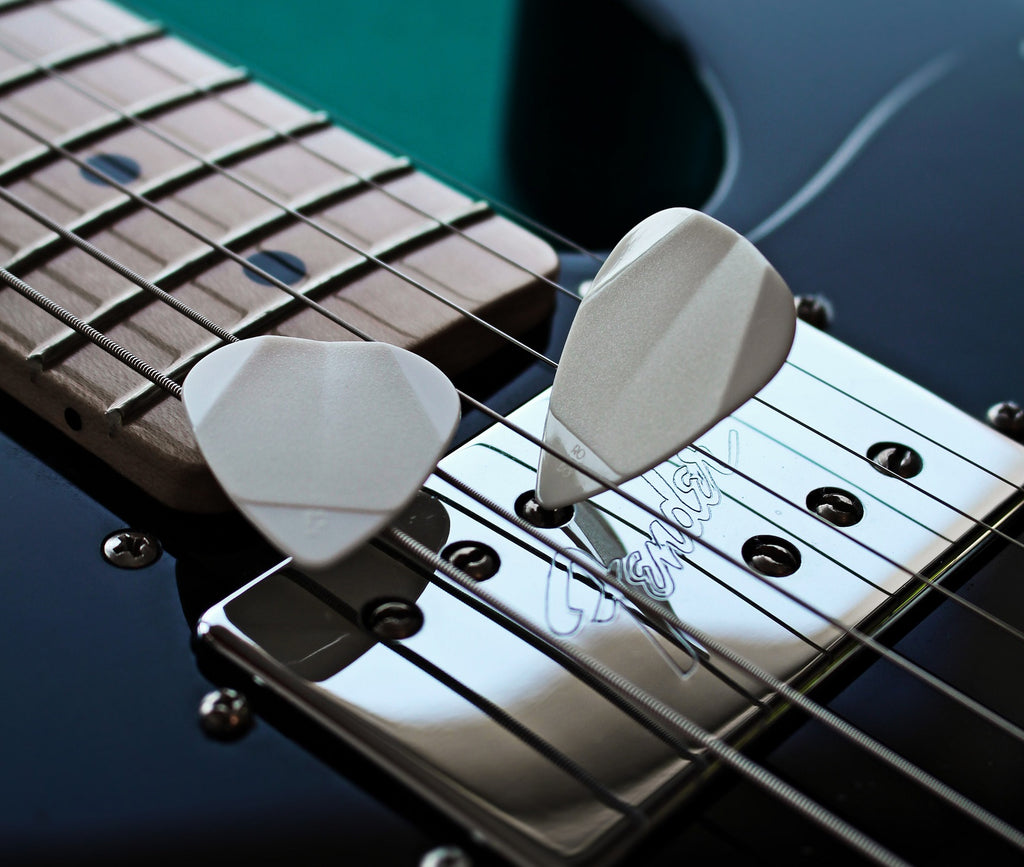
In my case, I have found the best stability and speed using Rombo Origami. This pick can be described as: Flexible but still rigid enough for note control. Right amount of flexibility for a snappy fluid attack that's bright and crisp. The concave surface on the hold area ensures an ergonomic and comfortable hold.
Everyone’s hand is a little different in how they hold the pick and move. The best way to find out is to test different shapes and thicknesses, and then try them out
Good luck!
2- PICK SLIDES:
One very extended technique often performed in the rock, metal, and punk genres is pick slides or pick scrapes.
By holding the edge of the guitar pick against the guitar strings and moving it along the edge, the pick catches the strings’ windings, causing the strings to vibrate and produce a very pleasant textured noise.
Usually, guitar pick slides start near the bridge and end over the higher frets. However, there are countless variations of pick slides depending on the direction, the angle of the pick relative to the strings, and other variables.

Unfortunately, performing pick slides completely ruins the edges of the guitar pick, especially on thinner ones. This won’t directly affect the tone or control of the plectrum, but the damaged sides will develop some dents.
What makes a guitar pick durable? Find our here.
WHY ARE PICK SLIDES IMPORTANT?
Guitar pick slides are not the most relevant aspect of your playing. Nevertheless, a correctly performed slide in the right place will add so much to the moment.

The noisy textures produced by this technique are the perfect weapon of choice for songs using high distortion levels.
A FAMOUS SONG WITH PICK SLIDES:
The first use of the pick slide is attributed to Bo Diddley and can be heard in the opening of his song "Road Runner" from the 60s.
Today, some guitarists have taken this technique to a new level and have created signature variations. A shining example of pick slides from the last years is the metal band Gojira with their famous signature “Gojira-Scrape” that was created by accident and combines several guitar pick techniques
BEST PICK FOR PICK SLIDES:
If you are going to do pick slides frequently, then you need to consider two things:
- Using durable guitar pick materials, and
- Using thick picks.
Otherwise, your guitar picks will be inoperative after a couple of sessions. The dilemma is that most players get better noisy sounds with a medium guitar pick.

I have found a solution that works for me: medium-heavy picks that are large enough to scrape with higher areas of the pick that won’t touch the strings. From our picks, I prefer Rombo Horizon the most for pick slides. Also, the curvy edge creates different pressure on different strings and that’s nice.
3- PINCH HARMONICS:
Do you know any guitar player who does not like pinch harmonics? I do not either.
Pinch harmonics are created by the picking hand. Playing this technique produces high-pitched tones. This phenomenon occurs when you stop a part of the string vibrations in the right position and create a "node".

There is a simple way to test this; pick a note and apply a small pressure anywhere on the string such that the vibration doesn’t stop completely.
WHY ARE PINCH HARMONICS IMPORTANT?
Pinch harmonics are often related to high gain tones and metal music but they are a powerful tool to add dynamics and textures to any genre of music or type of guitar; electric or acoustic.
It is considered one of the most abstruse techniques for intermediate players. Common problems are pinch harmonics that aren't loud enough or additional noises that make the harmonics not sound clean enough.

Root causes of this problem can be:
-
the guitar player does not know the right places on the strings to play pinch harmonics
-
there is unwanted noise coming from unmuted strings
-
the pinch harmonic is produced isolated, without combining it with other techniques like vibrato.
Most guitar players (including me) played their first pinch harmonic accidentally.
A FAMOUS SONG WITH PINCH HARMONICS:
Guitarist Billy Gibbons from ZZ Top is considered the father of pinch harmonics. Not because he invented them, but because he brought them to the mainstream. Although he is a well-rounded guitarist with a focused skillset based on blues, he is best known for his pinch harmonics.
BEST PICK FOR PINCH HARMONICS:
There is no special pick to do pinch harmonics. The pinch harmonic is technically produced by the thumb of your picking hand.
However, this technique is widely used in lead guitar in combination with other advanced techniques that work especially well with thick, small guitar picks.
Therefore, although you can learn pinch harmonics using thin picks, I recommend using thick picks.
 #If you want to learn more about the differences between thin and thick guitar picks read our article "Thick guitar picks vs thin guitar picks".
#If you want to learn more about the differences between thin and thick guitar picks read our article "Thick guitar picks vs thin guitar picks".
4- PALM MUTE:
Palm mute is a very regular technique used by most guitarists. By placing the side of the picking hand on the strings close to the bridge and dampening the guitar strings (when necessary), the strings produce muted sounds.
You can control the dampening effect by moving your hand to a different position further from the bridge.

Although this technique isn't seen as a very difficult one, these are common mistakes that prevent players from learning it properly:
- wrong hand position
- not having a relaxed posture
- problems by keeping a stable tempo
- too much pressure on the strings
WHY IS PALM MUTE IMPORTANT?
As a guitarist or bassist, you are always on the lookout to make your music sound natural, creative, and exciting.
Palm-muting is a great skill for dynamic control exercises. This means you will automatically learn how to shape your sound using fluctuations in volume and intensity.
With this skill in your repertoire, your music will sound more vocal and dynamic.
A FAMOUS SONG WITH PALM MUTE:
This technique is very old. As old as the invention of the electric guitar (1936). Most classical players have been using it for centuries with all kinds of instruments.
Today, palm muting is widely used in heavy metal, thrash, speed, and death metal. It is often found in music that features distortion effects.
Is there any good song to practice palm muting for getting better at it? “Master of Puppets” from Metallica—it’s a masterclass in palm muting and down picking.
BEST PICK FOR PALM MUTE:
I recommend using a thick guitar pick for this. They provide high volume, a broader dynamic range, and more control over single notes (in case you use palm mute arpeggios). In addition, palm muting is a demanding technique that causes a lot of guitar pick wear. As you might know, thick guitar picks are more durable.

My favorite choice for this technique is Rombo Diamond.
5- PICK STRUMMING:
Guitar pick strumming is a way of playing guitar. A strum is a sweeping action where a pick (or finger!) brushes over the guitar strings and generates sounds.
For most guitar players, this is the first technique they learned and the technique that caused most headaches as a beginner.

Learning how to strum correctly takes time and practice. Most beginners lack the necessary muscle memory it takes to play while remaining relaxed or having a good posture.
WHY IS PICK STRUMMING IMPORTANT?
In many ways, understanding this skill is essential for understanding guitar. Great strumming skills mean being a great rhythm guitarist. Therefore, this should be your number one goal as a beginner.
Learning chords is important, but they are just static shapes. The diversity of the hundreds (if not thousands) of strumming patterns available will inject musicality and rhythm into your playing.
A FAMOUS SONG WITH PICK STRUMMING:
“Bad moon rising” by Creedence Clearwater Revival, is a good place to start. It combines easy chords (D, A, G) with a very simple progression and a very catchy, bluesy melody.
BEST PICK FOR STRUMMING:
My best advice for beginners is to start with a very thin guitar pick. It can help to practice with something below 0.6 that’s nice and bendy. As you improve your skills, you can try with thicker picks, as they will add more bass to your tone.

For all the beginners out there, my best choice would be Rombo Classic.
However, if you are in the very beginning of your guitar journey, please read this article where I explain, why starting with medium guitar picks can be a better choice for you. "Medium Gauge Guitar Picks".
6- DOWNPICKING
Downpicking or down-stroke picking is a very beloved guitar technique in which the player moves the guitar pick only in a downward motion. The tip of the pick does not brush the strings as the hand moves back to the original position for the next down-stroke.
It is one of the most underrated skills on guitar and although performing this technique might seem easy, the required endurance for long passages with fast tempo is very often a problem even for advanced guitarists.

WHY IS DOWNPICKING IMPORTANT?
But first, why would you want to remove the upstrokes (alternate picking) and then increase the necessary effort for the same number of strokes? Why would you torture your wrist muscles in this way?
This technique is widely used in metal and punk guitar and the main reason is that when mastered, downpicking can make the guitar’s sound very powerful and rhythmic.
A FAMOUS SONG WITH DOWNPICKING:
Famous punk guitarist Johnny Ramone used this technique in the mid-70s in combination with fast tempo (180 to 200 bpm). The technique was very innovative at that time and influenced many current guitarists like James Hetfield who has been regarded as “the King of Downpicking”.
Many beginner guitarists start with songs from Ramones because of their simplicity in terms of chords and lack of tempo variations.
BEST PICK FOR DOWNPICKING:
For downpicking, there is a basic rule: the more mass the guitar pick has, the thicker and more aggressive the sound.

Therefore, a thick, large guitar pick with a pointy tip will be the loudest and most rhythmic one.
I recommend Rombo Diamond.
7- HYBRID PICKING
The interesting thing about hybrid picking is the fact that the player uses a plectrum as well as one or more fingers. This can be done alternately or simultaneously.
Typical styles for this technique are rockabilly guitar, country and bluegrass, and more classical passages with acoustic or classical guitar.
Hybrid picking can be very hard if you are a beginner. Before you think of learning this technique, you will have to learn how to play with your fingers and with a guitar pick. This is a requirement you cannot avoid.

WHY IS HYBRID PICKING IMPORTANT:
Three major arguments should convince you to learn hybrid picking:
Tone diversity:
The pick is generally used to play bass notes with a longer duration and very noticeable timbral differences caused by variations in the vibration of the strings. Therefore, your playing will sound more interesting combining pick and fingers.
Timing:
Hybrid picking allows you to pick two to four strings simultaneously. This makes it very different from strumming and gives an approach much more similar to piano techniques.
Flexibility:
Managing this technique, you will be able to change between fingerstyle playing and guitar pick playing within the same song or passage.
A FAMOUS SONG WITH HYBRID PICKING:
Hybrid picking was popularized by guitarists like Steve Howe some decades ago. Most players that learn this technique today start with a more classical approach.
A great song to start with this technique is “Amy” by Tommy Emmanuel. However, the complexity of the chords makes this song only possible to play for intermediate and advanced players.
BEST PICK FOR HYBRID PICKING:
There is no such thing as a “good” or “bad” pick for hybrid picking. You can use the pick you think fits the best for the song you are playing.
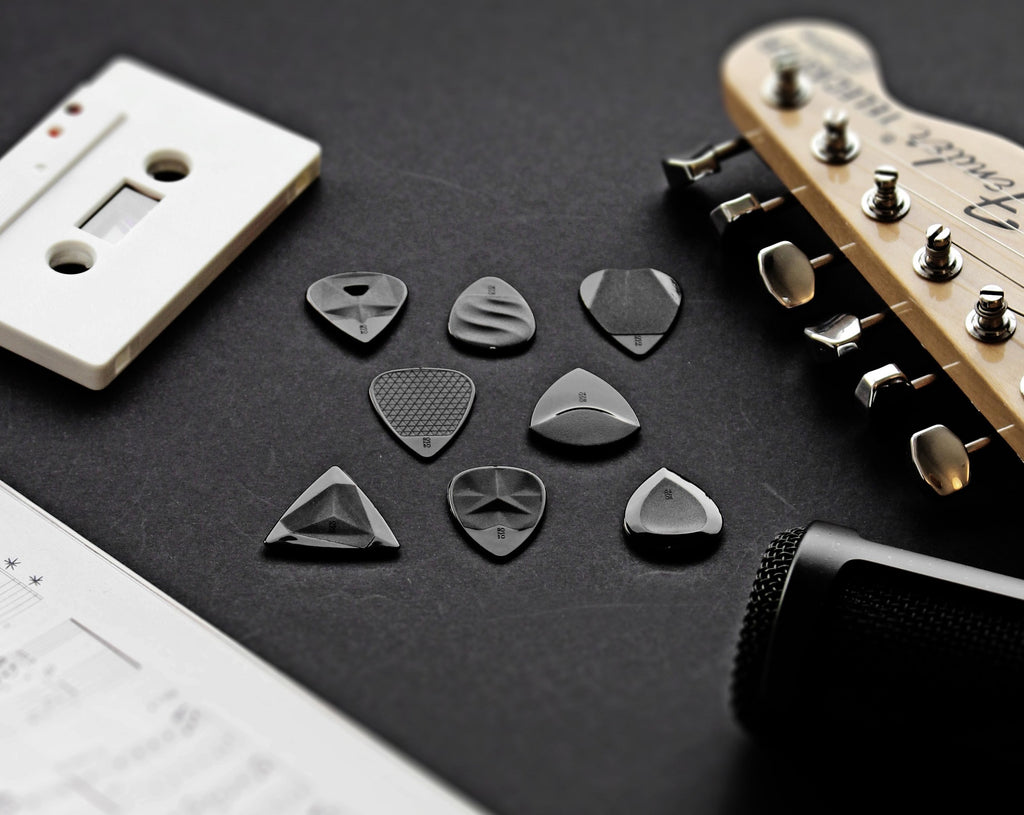
Because this technique is widely used by rhythm guitarists, there is a consensus that picks around 1 mm will perform well. However, it is up to you to try and decide which one is best for every passage.
Discover more about guitar pick thickness here.
8- BONUS SKILL – SWEEP PICKING:
For some reason, sweep picking is the trend. Every guitar forum gets new threads with this topic week after week. Perhaps it’s due to the high speed and visually nice arpeggios that make the guitar produce cyclical sound patterns and put us in a status of trance.

This technique describes the action of playing single notes on consecutive strings using the same motion, either all down-strokes or all upstrokes.
Sweep picking has been recognized as a difficult technique. It is more for advanced players and it can take years to master it.
WHY IS SWEEP PICKING IMPORTANT?
Sweep picking is used by guitarists to play arpeggios at high speed. The phrasing sounds produced by this technique sounds typical of other instruments like the piano.
Although sweep picking is a very important technique for building speed and fluency on string instruments, my advice would be to not learn this technique unless you have mastered other techniques that can give you more versatility.
Sure, it is ok to use sweep picking occasionally but that is not what you are going to play most of the time. In my opinion, a lot of bands overuse this technique. Therefore, you should reflect if the time needed to correctly learn sweep picking could be used for other more relevant skills.
A FAMOUS SONG WITH SWEEP PICKING:
Although often regarded as a “modern guitar technique”, pick sweeping has been around since the 50s. The technique was first used and developed by jazz guitarists.
Today, it is commonly used in metal but many students start with the song “Give Me the Night” by George Benson. Practicing sweep picking with clean tones can help you develop a more accurate technique.
BEST PICK FOR SWEEP PICKING:
What qualities are you looking for in a pick to perform sweep picking? Small and easy to handle, good maneuverability and stability, and good string separation. This means: Thick, pointy guitar picks like Jade or Horizon.

However, I have a bonus for you: We have received some E-Mails from professional guitarists using Rombo Prisma for their sweeping techniques, a pick that wasn’t developed for this. However, its sharp tip, combined with a very large, beveled edge, and the total “mass” of the pick (variable thickness), makes this pick a great candidate for bright tonal sweep picking solos.


How To Hold A Guitar Pick
In case you are trying to learn the guitar, the first thing you need to know is how to hold a guitar pick the right way.
Guitar pick or plectrum is a small object that you hold in your hands and play the guitar strings. The quality of guitar you are playing depends mainly on the way you are holding its pick.
So, before you officially start learning guitar, you should learn to hold the plectrum in the right manner.
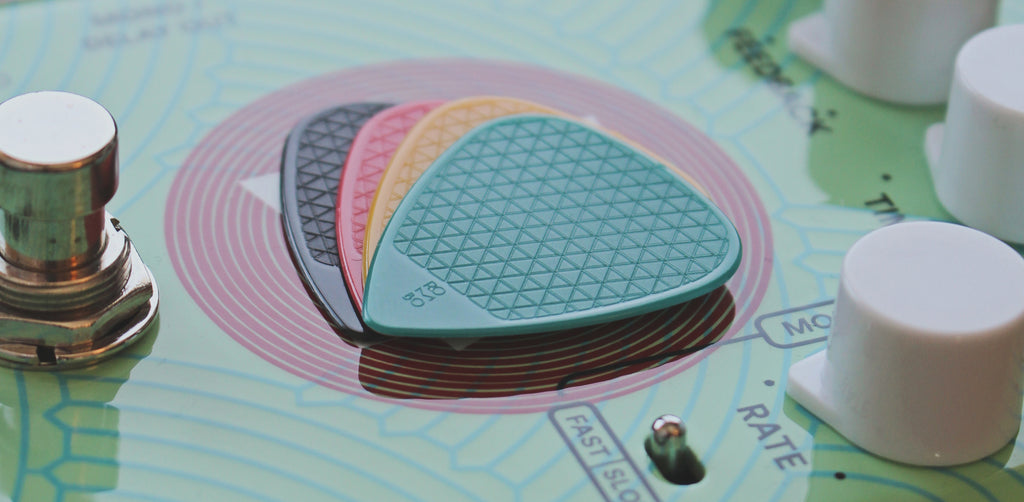
Mentioned below in this article are some of the tips and tricks which you can use for holding the guitar pick in your hand so that it doesn’t feel awkward and helps you in playing the guitar in the most suitable way.
Holding A Guitar Pick
The first and the easiest manner of holding a guitar plectrum is that you keep it in between your index finger and your thumb. Hold it in a way that it fits tightly in between your fingers. Now keep the position of your in such a manner that it can easily brush all the strings of your guitar.

As while playing, you will have to move the plectrum all over the strings and in order to be able to play guitar perfectly, the plectrum needs to touch all of the strings easily.
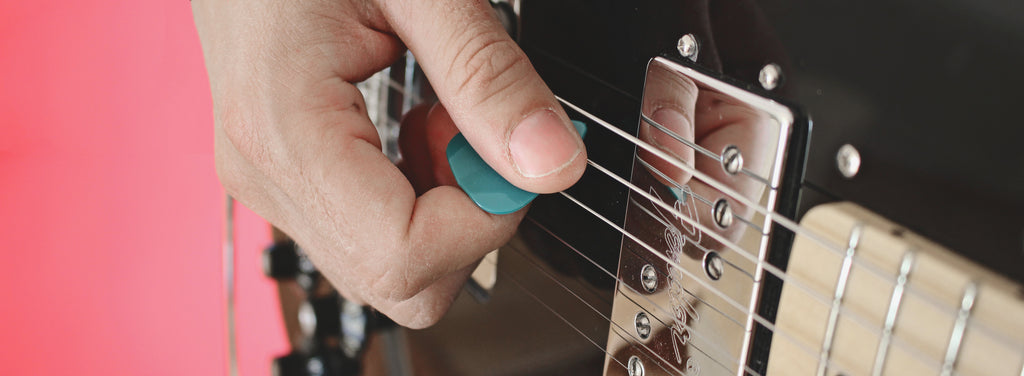
One thing that you need to keep in mind is that there are a lot of different types of plectrums available in the market and you should choose the one that works best for you. Once you have chosen the perfect pick, try to practice with it as much as possible.
We created a four-step guide to choosing your guitar pick, which you can find here:
https://rombopicks.com/blogs/insight-rombo/how-to-choose-the-right-guitar-pick
Brush it against the strings of your guitar so that your hands move easily and it produces a sound.
More Methods For Holding A Plectrum
Another technique that you can use to hold a guitar pick in your hand is that you keep it in your dominant hand. This is the hand that you use the most, so it will be easier for you to keep the plectrum in it and play the guitar.
Some people prefer to play the guitar chords with the hand that they don’t use more often i.e non-dominant. So by holding the plectrum in your dominant hand and controlling the chords with no dominant one, you can easily brush the guitar strings and produce music.

Now place your one hand on the neck of the guitar and hold the plectrum between your index finger and thumb of the dominant hand. Keep in mind that the strings of your guitar are facing away from you. Keep the guitar on your knees, as for a beginner, it is easier to play the guitar while sitting. But in case you want to play standing up, you can use a shoulder strap so that it is easier for you to control.
Keep your hand steady but flexible. Steady because you need to hold the guitar plectrum and flexible because you need to keep brushing it over all of the strings.

A good sound will only be produced if you are moving your hands the right way. Keeping them too rigid will result in an unpleasant sound which no one likes to listen to. But once again, keep in mind that a good sound can only be produced after practice.

During the initial times, you only need to focus on getting your hands used to the guitar. So that it knows where the strings are, which chords to play and where to keep the plectrums. These are the basic skills that everyone needs to learn before officially starting out various tunes on the guitar.
For those more advanced guitarists looking to improve their guitar playing speed, click HERE.
Things To Keep In Mind
Once you are in your comfortable position, rest your hand holding the plectrum on the strings of the guitar. Keep in mind that your hand should cover at least half of the plectrum. Some of the picks are made in a way that they are folded from one side to easily fit your index finger and your thumb on it.

Here you can find an example: Rombo Origami
Keep the grip of your hand as firm as possible but make sure it is easily movable so that once you start playing, you can brush the strings without making any extra effort. Never loosen your grip on the plectrum because it might fall off your hand while playing.
More Things To Focus
Now if you are a beginner, it is good that you are trying to get as much help as possible because this will help you in becoming a good guitarist within a minimum amount of time. By now, you do know how to carefully hold a plectrum (i.e between your index finger and thumb) now rest it over the strings.
Keep in mind that it should just lightly brush them so that only placing it there doesn’t produce any sound. The sound of your guitar must only be produced once you are moving the plectrum all over the strings.

One side of the strings is thin while the other one is thicker, practice on your guitar by gently moving your hand from the thicker side of the string to the thinner one. Although during the initial stages, rhythms produced would be rough but don’t worry about it. As you are only learning to hold the plectrum in the right way. There is a lot of time for learning guitar but prior to that, practicing is the most important thing that you need to do.
As this is the starting phase, try to practice as much as possible. As practicing will not only make your hand steady but it will also help you in maintaining your physical strength. The more your practice, the better you will be at playing guitar.
All successful guitarists need to play for hours in front of their audience and a person is only able to do that if he has done enough practicing.

So, in case you are taking more time trying to hold the guitar plectrum in the right way, tune the string or adjust the strap, don't worry about it. As all the great guitar players have started from this exact step so just polish your skills and you too will be an amazing guitarist really soon.
Note: There are many annoying things in life, but there’s nothing more annoying than losing a guitar pick you just had in your hand, and then realize that it has disappeared forever! - 4 Tips To Not Lose Your Guitar Picks
The Guitar Picks We Use Impact How We Play
If your hands do an arduous job, then you must give them the right tools, right?
The material with which it is made can influence the definition of tone, attack, and flexibility. Therefore, without paying attention to it, you could hardly find your personal sound.
Are you curious about the materials used for the Rombo guitar picks?
Read a full article about it here:
https://rombopicks.com/blogs/insight-rombo/guitar-pick-materials-at-rombo
Folge uns
Judith Heindorf & Carlos Diez Macia GbR
Auf der Steige 29
71686 Remseck am Neckar
DEUTSCHLAND
- Shop
- Händler
- Impressum
- AGB
- Widerrufsrecht
- Versandbedingungen
- Datenschutzerklärung
- Kontakt
- Presse
- Fragen & Antworten
Melde dich zu unserem Newsletter an und erhalte alle Neuigkeiten zu Sales, Neuerscheinungen und vielem mehr…
Mit der Anmeldung stimmst du unseren Datenschutzbedingungen zu.
© 2025 ROMBO.
ist eine registrierte EU-Marke.
Wir nutzen Shopify.

